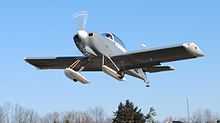Van's Aircraft RV-8






The Van’s RV-8 is a tandem two-seat, single-engine, low-wing homebuilt aircraft sold in kit form by Van’s Aircraft. The RV-8 is equipped with conventional landing gear, while the RV-8A version features tricycle landing gear. The design is a larger development of the RV-4, and is similar in appearance, although larger, than the earlier model.[3][4][5]
Development
Richard VanGrunsven designed the RV-8 series as an improved RV-4, itself a two-seat version of the single seat RV-3. The RV-8 first flew in 1995 and was first shown publicly at Oshkosh that year.[1]
The RV-8 incorporated changes as a result of lessons learned in producing the popular RV-4 design. The RV-8 airframe will accept larger engines, including the Lycoming IO-360, up to 200 hp. The RV-8 also has increased wingspan and wing area over the RV-4, as well as more cockpit width, headroom, legroom and an increased useful load, all with a view to accommodating larger pilots. Like the RV-3 to RV-7 that preceded it, the RV-8 is stressed for aerobatics.[1][5]
The RV-8 shares many common parts with the RV-7 and RV-9 which reduces production costs. Like the RV-7, the RV-8 uses computer assisted design to produce a kit with pre-drilled rivet holes, thus greatly reducing assembly time for the builder.[citation needed]
The RV-8 was intended from the start to have a nose-gear stablemate designated the RV-8A. The RV-8A was first flown in 1998 and features tubular steel landing gear with the nosewheel mounting tube welded to the engine mount. As in all nose-wheel equipped RV aircraft, the nosewheel is free castering and the aircraft is steered with differential braking. The brakes are mounted conventionally on the rudder pedal toes.[citation needed]
By August 2012 1143 RV-8s and RV-8As were flying.[2]
Specifications (RV-8)
Data from Van's Aircraft[6][7]
General characteristics
- Crew: one
- Capacity: one passenger
- Length: 21 ft 0 in (6.40 m)
- Wingspan: 24 ft 0 in (7.32 m)
- Height: 5 ft 7 in (1.70 m)
- Wing area: 116 sq ft (10.8 m2)
- Empty weight: 1,120 lb (508 kg)
- Gross weight: 1,800 lb (816 kg)
- Fuel capacity: 42 U.S. gallons (160 L; 35 imp gal)
- Powerplant: 1 × Lycoming IO-360 four cylinder, horizontally opposed piston aircraft engine with fuel injection, 200 hp (150 kW)
Performance
- Maximum speed: 221 mph (356 km/h; 192 kn)
- Cruise speed: 210 mph (182 kn; 338 km/h) at 75% power at 8000 feet
- Stall speed: 58 mph (50 kn; 93 km/h)
- Range: 940 mi (817 nmi; 1,513 km) at 55% power and 8000 feet
- Service ceiling: 22,500 ft (6,858 m)
- Rate of climb: 1,900 ft/min (9.7 m/s)
- Wing loading: 15.5 lb/sq ft (76 kg/m2)
See also
- Related development
- Aircraft of comparable role, configuration and era
References
- ↑ 1.0 1.1 1.2 1.3 "Van's Aircraft - Total Performance RV Kit Planes". Vansaircraft.com. Retrieved 2012-08-21.
- ↑ 2.0 2.1 Vans Aircraft (5 April 2013). "First Flights". Retrieved 5 April 2013.
- ↑ Downey, Julia: 2008 Kit Aircraft Directory, Kitplanes, Volume 24, Number 12, December 2007, page 77. Primedia Publications. ISSN 0891-1851
- ↑ Vandermeullen, Richard: 2011 Kit Aircraft Buyer's Guide, Kitplanes, Volume 28, Number 12, December 2011, page 74. Belvoir Publications. ISSN 0891-1851
- ↑ 5.0 5.1 Bayerl, Robby; Martin Berkemeier; et al: World Directory of Leisure Aviation 2011-12, page 125. WDLA UK, Lancaster UK, 2011. ISSN 1368-485X
- ↑ "Van's Aircraft - RV-8 Specifications". Vansaircraft.com. Retrieved 2012-08-21.
- ↑ "Van's Aircraft - RV-8 Performance". Vansaircraft.com. Retrieved 2012-08-21.
External links
| Wikimedia Commons has media related to Van's Aircraft RV-8. |
| ||||||||
| ||||||||||||||